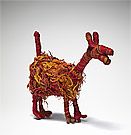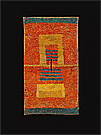Curriculum links Design/Tech
Fibre production
When ancient Peruvians began to produce clothing, they made textiles firstly from raw materials found in the plant world and then from the fleece of various camelids (llama, alpaca, vicuña and guanaco). Materials such as reed, agave, hemp and bulrush were used to make objects such as baskets, sandals and slingshots. A second group of materials needed to be spun for weaving, entailing twisting the thread giving it elasticity and strength. This group included cotton (Gossypium barbadense) or camelid fleece which weavers made into fibres to be used as warps and wefts. Ancient Andean peoples wove on backstrap, stake (or peg) and vertical looms. To give shine and colour to the textiles, fibres were treated with animal, vegetable and mineral dyes, combined with mordants such as alum and urine, to prevent fading. As the artists experimented with fibres, their knowledge and skill development enabled them to make garments that were more comfortable, lighter and tailored to fit the wearer’s body shape.
- Research the use of natural dyes and mordants in ancient Peruvian cultures by reading entries on a number of textiles in the Gold and the Incas exhibition. Consider how fabric is dyed in the contemporary world. Locate and list Australian textile manufacturers today who use natural dyes and are committed to sustainable production.
- Find a textile in the Gold and the Incas exhibition that has design links with the architectural features of one of the main sites of ancient Andean culture such as the city of Chan Chan or the Gateway of the Sun at Tiwanaku. Describe the connection between the architecture and textile design.
- Investigate the variety of ways the quipu was used in ancient Peru. How did the quipu revolutionise society by the time the Incas came to power? (hyperlink to quipu)
- Choose a weaving technology that was used to make a textile in the Gold and the Incas exhibition. Discuss the advantages and limitations of this technology. Consider the backstrap, stake (or peg) or vertical loom in your response.
- Research the ways feathers were obtained and used as ornamentation in ancient Peru. Find a number of objects in the Gold and the Incas exhibition that were made from feathers or used feathers as an inspiration for their design. Consider whether the feather trade was sustainable when the Spanish arrived.
- Compare and contrast the design of contemporary canoes made by Australian artist, Rex Greeno and the reed canoes used by seafaring Andean people. Study the Inca object in the Gold and the Incas exhibition—Vessel in the form of a man on a reed raft and further information about Rex Greeno’s canoes on the National Museum of Australia’s website— http://www.nma.gov.au/museum_magazine/issue_three/an_ingenious_construction
- Choose three motifs or design elements that appear on textiles or ceramics in the Gold and the Incas exhibition that have been appropriated in contemporary fashion design. Compare a contemporary piece with a work from the Gold and the Incas exhibition, discussing the similarities and differences. (Hyperlink to Mario Testino in Visual Arts?)
- Design a textile using an open weave technique that would be strong enough and practical enough to use for fishing. Refer to the Chancay open-weave textiles with fish and cat design.
- Experiment with colouring fibres using natural dyes. Design a textile incorporating various motifs you discover in the Gold and the Incas exhibition. Design and produce a loom for making your textile using ancient Peruvian technology.
- Design a quipu that could be used for a multitude of tasks including a narrative or economic purpose. You may like to design a quipu to manage your personal budget or to tell a fictional adventure story based in ancient Peru.
- Create a virtual textile focusing on a recurring motif in the Gold and the Incas exhibition such as a stylised shaman figure, Ai Apaec or the Lord of Sicán.
- Create your own individual motif for a Huari-style tunic that is inspired by your research about the Huari culture. Why have you chosen this motif and what does it mean?
- Design a t-shirt motif that reflects the notion of duality as depicted in the Gold and the Incas exhibition. Discuss this concept as a class before you begin. Use works of art as a stimulus such as the gold and silver combinations or the Inca chequerboard design. Your t-shirt design could also be inspired by composite animal beings that reference the Andean vision of the three worlds. Evaluate your work and consider if your t-shirt could be worn by the visitor services staff at the National Gallery of Australia to endorse the Gold and the Incas exhibition.
- Textiles had many uses in ancient Peruvian culture. Finely finished colourful fabric was crafted for political leaders to wear during ceremonies to display their rank and importance. Textiles were important in religious offerings and were used to adorn religious effigies as well as being burned as a sacrificial offering. Even in death textiles accompanied the elite members of society on their transition to the afterlife. Design a group of textiles inspired by the Gold and the Incas exhibition that could be used for your school environment to identify the principal, heads of department, classroom teachers, students and parents OR think of another work environment today where a range of fabrics and designs could help to identify the status of wearers.






